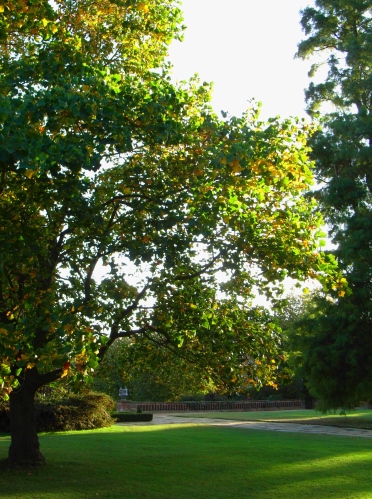Welcome to my rather belated follow-up about climbing roses. I hope you find it helpful!
All the things I said about tools, hygiene, angles of cut and roses being as tough as nails in my how-to about pruning shrub roses also apply here. You might also need a ladder – be careful! No leaning out from the ladder or placing it on wobbly ground. It’s naughty and I never do it myself. Honestly.
As before, the first step is to stand back and look at your rose. If it has an existing framework of main stems are there gaps in it? Are any existing bits of the framework dead or diseased or just really old and gnarly? Are there any conveniently placed strong new stems that could be tied in to fill these gaps and replace the dead bits? If there’s no framework yet, which are the strongest looking stems? Are these strong stems flexible and in good positions?
Just a quick note on framework stems – it is best to tie them in as close to horizontal as possible as this encourages more flowering. This means a roughly fan or ladder-shaped framework is best. Which stems are framework stems? Any you choose to use that way really – healthy strong looking ones for preference.
Now to start hacking! Cut all the stems back to two or three buds from the framework except any you’re saving for the framework. Careful – this is a prime moment for accidental amputation of the wrong bit and I don’t mean fingers (although that would be worse as they don’t grow back!) Remember to cut back to a bud pointing outwards and upwards if possible. Then completely remove any dead, diseased, crowded or badly placed bits.
If this is the climber’s first year you won’t be cutting much, if anything, off at all. Having said that, it is worth shortening your new framework stems by a few inches to a strong bud as this will encourage branching and expand your framework for next year.
Here’s a close up example of using a stem to create a fuller framework:
You can see there’s a bit of a gap in the middle of this area and to the left there’s a strong and flexible stem which might be a good candidate to fill the gap, as long as it doesn’t break when I try to bring it round. This can be a problem if you want a stem to go in a very different direction to it’s original growth – if you have a stem that is already going in the right direction it’s better to use that.
You can see I successfully filled the gap and cut back all other stems to a few buds.
So once you’ve chopped off everything that needs chopping tie in your new framework stems and replace old ties. For tying in I mostly use twine but have also discovered Soft-tie which consists of a wire core covered in rubber and I now use it for holding up the main support points of the heftier roses which can suffer badly from twine ties. A big old rose is quite a heavy beastie!
And that’s it. Ta da! Job done.

So that’s climbers. What about rambling roses? Ramblers generally have masses of small flowers, rather than single larger ones, and are often a lot more vigorous than a climber. They can be treated as a climber if there isn’t really the space to just let it go, otherwise just keep it within its allotted space and cut out anything dead or diseased and the occasional old stem.
Good luck with your roses and try not to fall off any ladders!





























